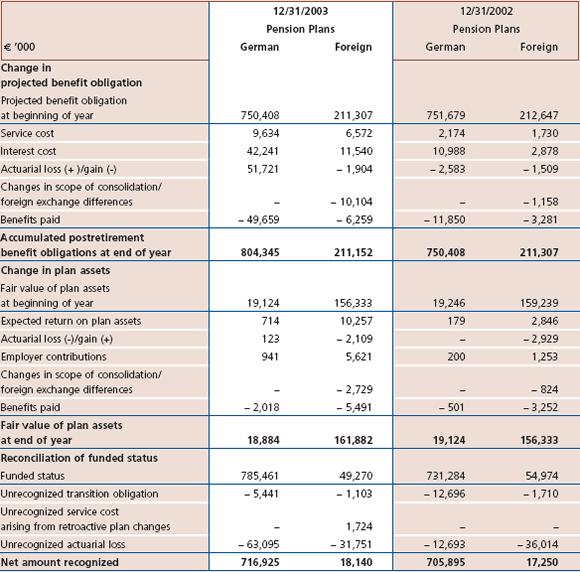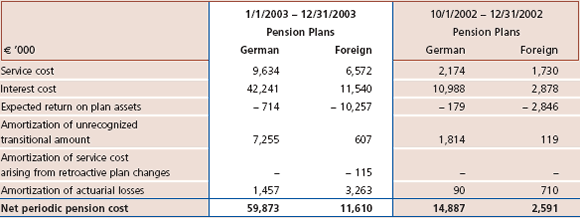Provisions and accruals are composed as follows:

Provisions and accruals of €423.630 million are attributable to Dynamit Nobel (prior year: €393.707 million.
Provisions and accruals due after more than one year were as follows:

a) Provisions for Pensions and Similar Obligations
These are broken down as follows:

aa) Pension Plans
The mg Group provides pension benefits to the majority of its employees. The benefits in Germany usually consist of pension payments. Employees generally receive fixed pension amounts per year of service. The subsidiaries outside Germany operate country-specific pension plans, some of which are funded. Benefit obligations in Germany are primarily unfunded.
With the exception of GEA, the German subsidiaries’ ongoing pension liabilities up to September 30, 1999 are valued using the Chemie 1996R pension fund mortality tables, while ongoing pension plans after September 30, 1999 and all benefits are valued using 1998 Heubeck tables modified for Groupspecific disability probabilities (35% for women and 50% for men). The Heubeck tables are used throughout for GEA.
The changes in projected benefit obligations and plan assets and the reconciliation of the funded status for the companies reported as continued operations are as follows:

Amounts recognized in the consolidated balance sheets for the pension plans of companies reported as continued operations consist of the following:

The net amount recognized is calculated by netting the accrued net pension liability (excluding the minimum pension liability) with the prepaid expenses.
The share of discontinued operations in the accumulated other comprehensive income/loss has been adjusted for the purposes of the above reconciliation. This amount is not reclassified like the accrued pension liability, prepaid expenses, and intangible assets in accordance with SFAS 144.
Actuarial assumptions used to determine costs and benefit obligations at NPV for the principal pension plans were as follows:

The actuarial assumptions for German pension plans were coordinated with actuarial experts Dr. Dr. Heissmann GmbH, Wiesbaden.
Components of net periodic pension cost for the plan for companies reported as continued operations were as follows:

The above tables give the fair values and the expected long-term returns on these plan assets for German pension plans. The returns are estimated based on both historical and future expected market and portfolio performance. €582,000 is expected to be allocated to German pension plan assets in 2004. The plan assets continue to be managed by benevolent funds and foundations and are mainly invested in fixed-income securities and fixed-term deposits. There are no plans at present to change this investment strategy. The accumulated benefit obligation (excluding future salary increases) for German pension plans amounted to €790.572 million in 2003 (prior year: €736.913 million). The balance sheet date used to report German pension plan assets is December 31, 2003.
ab) Defined Contribution Plans
The individual companies of the mg Group’s continued operations offer various postretirement benefits in the form of defined contribution plans. The pension cost of these plans lies not with mg but with the respective pension provider. Total contributions of €12.645 million (prior year: €639,000) were paid in 2003.
ac) Other Postretirement Benefits
In addition to pensions and similar obligations, the mg Group provides certain retired employees with postretirement benefits for health insurance premiums. The following information refers to the Group’s postretirement benefit plans in Germany.

Actuarial assumptions used to determine costs and benefit obligations for principal additional
domestic pension plans were as follows:

The inflation rate for German pension plans with respect to healthcare and life insurance costs is estimated to be 4.0% for 2004. The balance sheet date used to report German pension plans is December 31, 2003.
Components of net periodic postretirement benefit cost for the plan are as follows:

Additional postretirement benefits are also paid by two foreign companies. Their funded status at December 31, 2003 comes to €3.710 million (prior year: €4.361 million) and the net amount recognized for additional foreign postretirement benefits totals €4.242 million (prior year: €5.093 million). The relevant cost of these benefits in 2003 amounted to €353,000 (prior year: €103,000). Actuarial assumptions used to determine costs and benefit obligations for additional foreign postretirement benefits include a discount rate of 6.25% (prior year: 7.0% and 6.75%). These assumptions also took into account projections of the rising cost of medical and dental treatment benefits. The rise in the cost of medical healthcare benefits amounts to 15.0% and 9.0% (prior year: 8.5% and 9.5%). These costs will fall by 1.0% and 0.5% per year respectively (prior year: 0.5%) up to 2013 and 2011 (prior year: 2009 and 2011). The rise in the cost of dental healthcare benefits amounts to 7.5% and 9.0% (prior year: 7.5% and 9.5%). They will fall by 0.5% per year (prior year: identical) up to 2010 and 2011. There was no change on the prior year.
The following schedule presents the effect of a one percentage point change in the inflation rate on the service cost and accumulated postretirement benefit obligations for pension plans at December 31, 2003:

b) Provisions for Taxes
Provisions and accrued liabilities for taxes relate to current taxes and were largely established to cover foreign tax liabilities and future audits.
c) Other Provisions and Accrued Liabilities
Other provisions and accruals consist of the following:

Provisions for personnel expenditures largely comprise bonuses, vacation net yet taken, anniversaries, part-time retirement, and excess working hours accumulated. The rise is largely due to the increasing use of preretirement part-time contracts for staff over 55 years of age, which are being used as a way of reducing the headcount.
The environmental and recultivation provisions and accrued liabilities primarily relate to soil decontamination, demolition of buildings, waste disposal and treatment of effluents. Provisions with a nominal value of roughly €10.500 million were discounted at a rate of 5.5%. The discounted amount comes to approximately €4.000 million. In addition to the reported liabilities of €67.023 million there is a further maximum potential liability risk of €8.050 million. This additional risk is attributable almost exclusively to Dynamit Nobel.
Provisions for guarantee commitments, including guarantee commitments included in provisions for outstanding invoices and losses on long-term contracts, were as follows:

Provisions for guarantee commitments mainly relate to to GEA and the plant engineering business. The guarantees and warranties on which they are based are usually granted, as is customary in the industry, in connection with certain performance criteria relating to plant, equipment or products (e.g. output guarantee, quality of product manufactured). Guarantee commitments generally run for between one and two years from the time when delivery of the products, plant or equipment is accepted. In addition to guarantees explicitly agreed by contract, many countries also recognize product liability arrangements, which in some cases may stipulate that the manufacturer is liable beyond the contractually agreed life of the guarantee. If the products, plant or equipment sold fail to meet the contractually agreed specifications, the mg Group will be faced with claims under its guarantee. In some cases the mg Group can demand collateral in the form of insurance premium refunds or guarantees from subcontractors.
Provisions for guarantees are set aside on the basis of empirical values from similar products or based on the evaluated overall risk of the plant or equipment in question. The percentage of sales set aside as a provision will vary depending on the type of product, plant or equipment (general provision). General provisions are recognized at the time of final acceptance by the customer of the product, plant or equipment if the contract in question is accounted for under the completedcontract method. If it is accounted for under the PoC method, provisions are set aside according to the contract’s percentage of completion. If a claim is made under a guarantee and a loss is deemed likely, specific guarantee provisions are set aside to cover the anticipated cost (specific provisions).
The restructuring provisions largely relate to the reorganization of the remaining activities in connection with the strategic restructuring of the mg Group. For further information see Note H) ‘Restructuring’. Provisions of €83.736 million have been set aside for the future cost of reorganization. Personnel-related measures will account for €67.639 million of this amount. The majority of this cost relates to continued salary payments and severance payments to employees under social plans. The exit costs of €16.097 million concern plans to divest or merge certain industrial plant engineering activities (for further information see Note 18) ‘Restructuring Costs’).
The changes in these restructuring provisions are summarized as follows:

The €1.234 million increase in restructuring provisions owing to acquisitions resulted from the acquisition of Fleissner.
The remaining provisions have essentially been established to cover risks arising from litigation as well as the cost of legal advice and other advisory costs of €36.763 million (prior year: €32.744 million) as well as provisions for impending losses of €21.836 million (prior year: €6.763 million).